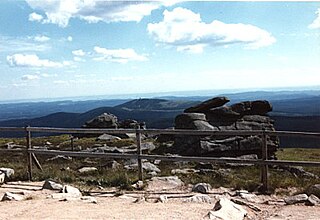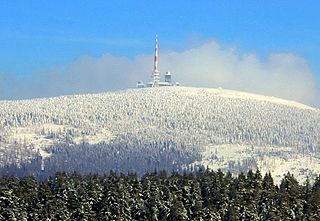
The Harz, also called the Harz Mountains, is a highland area in northern Germany. It has the highest elevations for that region, and its rugged terrain extends across parts of Lower Saxony, Saxony-Anhalt, and Thuringia. The name Harz derives from the Middle High German word Hardt or Hart. The name Hercynia derives from a Celtic name and could refer to other mountain forests, but has also been applied to the geology of the Harz. The Brocken is the highest summit in the Harz with an elevation of 1,141.1 metres (3,744 ft) above sea level. The Wurmberg is the highest peak located entirely within the state of Lower Saxony.

Harz National Park is a nature reserve in the German federal states of Lower Saxony and Saxony-Anhalt. It comprises portions of the western Harz mountain range, extending from Herzberg and Bad Lauterberg at the southern edge to Bad Harzburg and Ilsenburg on the northern slopes. 95% of the area is covered with forests, mainly with spruce and beech woods, including several bogs, granite rocks and creeks. The park is part of the Natura 2000 network of the European Union.

The Brocken, also sometimes referred to as the Blocksberg, is the highest peak in the Harz mountain range and also the highest peak in Northern Germany; it is near Schierke in the German state of Saxony-Anhalt between the rivers Weser and Elbe. Although its elevation of 1,141 metres (3,743 ft) is below alpine dimensions, its microclimate resembles that of mountains of about 2,000 m (6,600 ft). The peak above the tree line tends to have a snow cover from September to May, and mists and fogs shroud it up to 300 days of the year. The mean annual temperature is only 2.9 °C (37.2 °F). It is the easternmost mountain in northern Germany; travelling east in a straight line, the next prominent elevation would be in the Ural Mountains in Russia.

August Friedrich Pott was a German pioneer in linguistics.

Braunlage is a town and health resort in the Goslar district of Lower Saxony in Germany. Situated within the Harz mountain range, south of the Brocken massif, Braunlage's main business is tourism, particularly skiing. Nearby ski resorts include the Sonnenberg and the slopes on the Wurmberg.

The Harzburg, also called Große Harzburg, is a former imperial castle, situated on the northwestern edge of the Harz mountain range overlooking the spa resort of Bad Harzburg in Goslar District in the state of Lower Saxony, Germany. It was erected from 1065 to 1068 at the behest of King Henry IV of Germany, slighted during the Saxon Rebellion in 1073-75, and a century later rebuilt under Emperor Frederick Barbarossa and his Welf successor Otto IV, who died here in 1218.

Ilsenburg is a town in the district of Harz, in Saxony-Anhalt in Germany. It is situated under the north foot of the Harz Mountains, at the entrance to the Ilse valley with its little river, the Ilse, a tributary of the Oker, about six 6 miles (9.7 km) north-west of the town of Wernigerode. It received town privileges in 1959. Owing to its surrounding of forests and mountains as well as its position on the edge of the Harz National Park, Ilsenburg is a popular tourist resort. Since 2002, it is officially an air spa.
Elend is a district of the town of Oberharz am Brocken in the Harz District, in Saxony-Anhalt, Germany. It lies in the Bode valley in the High Harz in central Germany, at a height of 505 m above NN. This part of the valley is known locally as Elendstal. Elend is located near the former Inner German Border between West and East Germany. Its population is 318 (2021).

Georg Ernst Ludwig Hampe was a German pharmacist, botanist and bryologist who was a native of Fürstenberg.

The Forstbotanischer Garten und Pflanzengeographisches Arboretum der Universität Göttingen, often called the Forstbotanischer Garten und Arboretum, is a 40 hectares arboretum and botanical garden maintained by the University of Göttingen. It is located at Büsgenweg 2, Göttingen, Lower Saxony, Germany, immediately adjacent to the New Botanical Garden, and open to the public daily.

The Botanical Garden of TU Darmstadt is a botanical garden maintained by the Technische Universität Darmstadt.

The Botanischer Garten der Christian-Albrechts-Universität zu Kiel, or less formally the Botanischer Garten Kiel, is a botanical garden and arboretum maintained by the University of Kiel. It is located at Am Botanischen Garten 1, Kiel, Schleswig-Holstein, Germany, and open daily.
The Botanischer Garten Oldenburg, more formally known as the Botanischer Garten der Carl von Ossietzky-Universität Oldenburg, is a botanical garden maintained by the University of Oldenburg. Its public gardens are located at Philosophenweg 39, Oldenburg, Lower Saxony, Germany, and open daily without charge.
The Neuer Botanischer Garten der Universität Göttingen, also known as the Experimenteller Botanischer Garten, is a research botanical garden maintained by the University of Göttingen. It is located immediately adjacent to the university's Forstbotanischer Garten und Arboretum at Grisebachstraße 1, Göttingen, Lower Saxony, Germany, and open daily without charge.

The Zeterklippen are a striking rock formation or tor on the 930-metre-high Renneckenberg mountain, overlooking the Ilse valley in the Harz mountains in Germany. The Renneckenberg is an eastern sub-peak of the Brocken. The rocks themselves lie at a height of about 830 metres (2,720 ft) above sea level. They can be reached from the Molkenhausstern after about 2.5 km. The track initially runs uphill through dense spruce forest until the view opens out towards the Hohnekamm and down to Wernigerode. Then the route branches off to the right onto a steep, 0.5 km, path and, after about 200 m, a gentler 0.4 km path leads to the Große Zeterklippe. Immediately below this highest of the rocks is a mountain hut that dates to the time when a botanical garden had been laid out here as a replacement for the inaccessible Brockengarten.

The Ilse valley is the ravine of the Ilse stream in the northern boundary of the Harz mountain range in Germany. Part of the Harz National Park, it runs from the town of Ilsenburg at the foot of the mountain range up to the source region near the summit of the Brocken massif, the highest mountain of the range. The scenic valley is a popular hiking area.

The Hildesheim–Goslar railway is a 53 kilometre long, double-track and non-electrified main line in the northern Harz foothills in the German state of Lower Saxony. It serves mainly to connect with the tourist region in the northern Harz with Hildesheim and Hanover. It is served by the HarzExpress, running between Halle, Halberstadt, Goslar and Hannover Hauptbahnhof. The most important station and junction of the line is Salzgitter-Ringelheim station.

Die Harzreise is a travel report by German poet and author Heinrich Heine on a journey to the Harz mountains. Compiled in autumn 1824, it was first published as a serial in January and February 1826 in the magazine Der Gesellschafter by Friedrich Wilhelm Gubitz and ran for 14 instalments. Some censorship changes were made beforehand. Later in 1826 Die Harzreise appeared in the first part of the Reisebilder collection. For the book, Heine made revisions and changes, and added the famous Göttingen section. Heine himself described his record as a literary fragment. The book was the first of Heine's to be published by Hoffmann & Campe in Hamburg, the publisher who later brought out all Heine's writings.
Wilhelm Schacht was a German botanist, gardener, photographer and author. He became known for being senior staff member of Botanischer Garten München-Nymphenburg, whose open air department he took care of for 21 years.

"Harzreise im Winter" is a poem by Johann Wolfgang von Goethe, inspired by his ascent of the Brocken in the Harz mountains during the winter of 1777. He reached the summit in the heat of midday, in deep snow, with the landscape below him shrouded in cloud. The Brocken had always been a place of mystery, connected with witches and devils; where illusions such as the Brocken spectre might confuse an unwary traveller, and where few ventured by choice. This was the inspiration and the setting for his poem.


















